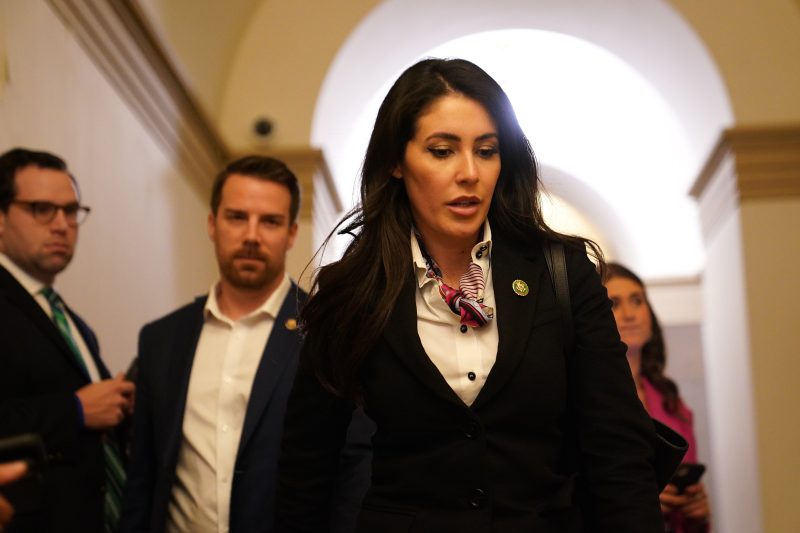It was the sort of dispute that erupts on a near-daily basis, a conservative politician seizing upon a critical opinion piece as a jumping-off point for disparagement of the media at large.
But this particular dispute, involving Rep. Anna Paulina Luna (R-Fla.) and a columnist at MSNBC, however unintentionally, also stumbled into more interesting territory — considering how demography and politics overlap and how our approach to race is often far simpler than it should be.
The fight began with a column by MSNBC’s Julio Ricardo Varela. He noted that the new 118th Congress had more Hispanic members than any prior Congress — but that the newly sworn-in members included progressive Democrats and pro-Trump Republicans.
Varela picked out Luna for particular criticism.
Luna, he wrote, “has ties to chief [House Speaker] Kevin McCarthy opponent, Rep. Matt Gaetz, R-Fla., and has worked with what I consider to be a MAGA white supremacist cult: Turning Point USA.” One should not be surprised that a Latina would be an adherent to MAGA — that is, Trump’s “make America great again” ideology — he wrote, since there were “plenty of Latinos and Latinas who instantly sided with the authoritarian xenophobe, and the MAGA movement has always had Latino support.”
“Though Luna’s ascension to the House of Representatives is certainly newsworthy,” he concluded, “it’s important that we journalists avoid placing too much emphasis on a representative of Mexican descent who’s signed on to a political movement that began with the demonization of Mexicans.”
Not mincing words, certainly, and Luna responded with equal ferocity. She highlighted the last sentence above, calling it “a twisted lie,” on her personal Twitter account. On her official government account, she took a different tack.
Wow. @MSNBC is really trying to paint me as a white supremacist? Honestly I’m pretty sick of left leaning media focusing so much on my race. It’s sad to see how triggered the left is over the fact that I’m conservative.
— Anna Paulina Luna (@VoteAPL) January 8, 2023
Here we see the hallmarks of an effort to gin up a media controversy: attributing to MSNBC broadly the words of one columnist and, for good measure, misrepresenting those words. She also offered a better-aimed criticism, that the column viewed her through the lens of race which, of course, was the entire point of Varela’s piece.
Then Luna went further.
“Obama was half white. Yet they said he was the first black President. I’m half white so that makes me not ‘Hispanic enough’, MSNBC?” she wrote in a follow-up tweet. “It’s pathetic to see how much the left harasses minority conservatives.” In an interview on Newsmax, she repeated this argument.
Again, this line of argument doesn’t really follow from Valera’s essay. He didn’t suggest she was somehow incompletely Hispanic because of her politics; on the contrary, he noted that there were many Hispanics who supported Trump’s agenda, to his frustration. His point was one that’s come up a lot in the past few years, that Hispanics, who traditionally vote heavily Democratic, had shown signs of shifting to the right.
That shift, though, reflects on Luna’s point: that Americans who have mixed racial identities are often presumed to share characteristics with one of their identities or the other. In other words, that racial demography is more complicated than we often recognize. Which is both true and (regardless of its applicability to her feud with Varela) underrecognized.
Let’s start with an overview of Varela’s first point: the shifting demography of Congress. The percentage of the House that is made up of White men dropped below 50 percent in recent years, although it’s still well above the 30-percent of the population that group constitutes in the country overall. The percentage of the House that is Hispanic, meanwhile, has risen over 10 percent, although it’s still well below the 19 percent of the population overall. (White women also are underrepresented in the House.)
A critical asterisk to this chart, though, is the definition of “White.” The data on Congress uses a process of elimination: anyone not identified as Black, Hispanic or Asian defaults into the White collective. The Census Bureau data, though, use a more precise definition: people who identify their race as White and don’t claim Hispanic ethnicity.
For decades now, this has been the distinction that the government draws: you have a race and you have an ethnicity. You can be White and non-Hispanic (like, say, President Biden) or White and Hispanic (like many people we generally consider Hispanic, presumably including Luna) or, say, Black and Hispanic (like some people from the Dominican Republic) or Asian and non-Hispanic.
The Census Bureau has endeavored to introduce more precision to this process by allowing people to describe their racial backgrounds in more detail. That’s a big reason that the percentage of White Americans fell in the 2020 census: there were more opportunities than in past years for Americans to describe the complexity of their family histories. A lot of people fell into a broader, vaguer multiracial grouping.
That’s the other important factor to the politics of all of this: racial and ethnic identifications include subjective assessments. This isn’t some sort of abstract, touchy-feely approach to race but, instead, a recognition of how the government collects this data and of how people approach their own identities. As I note in my upcoming book (which explores this subject at length), people often don’t consider the complexity of their own racial identities until prompted to do so by government forms. For many Americans, racial identity exists in Schrödinger’s-cat-style ambiguity until they are prompted to be definite about it.
What’s fascinating about the Luna-Varela discussion is the evidence that many people with Hispanic heritage become less likely to identify as Hispanic over time. In 2017, the Pew Research Center released analysis showing that people of Hispanic heritage were less likely to identify as Hispanic the longer their families had been in the United States.
There is other subtext here about the ability of different groups to assimilate into a mainstream American culture led by a White majority. That’s a complex, fraught discussion on its own. There is also an observed correlation between the pattern above and politics. As Jack Herrera argued in an important 2021 article for Texas Monthly, many long-standing Hispanics in Texas contrasted their own politics with those focused on newer arrivals.
“Hispanic residents of our state are much more likely to identify as white than Hispanic residents of cities elsewhere in the country,” Herrera wrote. “With roots many generations deep in lands that were annexed from Mexican control to that of the U.S., many also actively reject being cast as immigrants.”
In 2020, this region shifted toward Trump relative to 2016. So did heavily Hispanic parts of Florida, the state Luna represents.
Bringing us back to Luna’s argument. She claims she’s being dismissed as insufficiently Hispanic because she has a mixed heritage, which, again, wasn’t a point Valera was making. But her politics and her racial and ethnic background represent an interesting nexus at the moment: someone who identifies as Hispanic, votes as a Republican and has a family history that includes relatives of different races.
Just as Barack Obama before her represented a complex racial background, arriving at a very different political place. Each represents a different facet of America’s increasingly complex composition. Not exactly the point Luna was trying to make, but one worth making.








